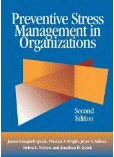“Preventive Stress Management in Organizations”

Preventive Stress Management in Organizations
By James Campbell Quick, Thomas A. Wright, Joyce A. Adkins, Debra L. Nelson, and Jonathan D. Quick
American Psychological Association
Washington, D.C., 2013
Laudable resource provides preventive strategies
Reviewed by James K. Luiselli, Ed.D., ABPP, BCBA-D
The authors of this book describe preventive stress management as “an organizational philosophy and set of principles grounded in public health that uses specific methods for promoting individual and organizational health while preventing individual and organizational distress.” Geared principally toward psychologists who work with leaders and organizations, the book is also intended for other helping professionals as well as employees who are concerned about reducing and eliminating occupational-induced stress.
There are 12 chapters in the book that consider assessment, treatment, and prevention of stress. The earliest chapters present a conceptual model for understanding stress within organizations and the role of public health, preventive medicine and psychological intervention in risk reduction. Notably, there is extended discussion about the negative impact of chronic stress on both individuals and organizations in terms of physical consequences, mental health problems, diminished performance on-the-job, and financial costs.
One of the strongest chapters in the book covers stress measurement, assessment and surveillance. Of course, being keenly aware of the sources of stress and how stress is manifested allows organizational leaders to intervene early through primary and secondary prevention efforts. The authors provide numerous examples of assessment methods, observational techniques, medical screening protocols and symptom monitoring checklists that can be combined to determine accurate stress profiles of individuals and organizations-at-large.
The topic of intervention is addressed in several chapters, starting with an introduction into the principles, theory and practice of preventive stress management. The authors do an outstanding job describing a wide spectrum of cognitive, behavioral, and health care strategies that are intended to mediate the onset of stress in everyday work life. Procedures for individuals who are at risk for developing stress are also explained extensively, as are therapeutic activities for those experiencing symptoms of chronic stress and those in need of a more intensive management plan.
The authors note that “preventive stress management draws on positive psychology and strength-based intervention,” and indeed, this orientation dominates the book in a fundamental way. Thankfully, they clearly articulate many empirically supported steps and processes for constructing an organization-wide program of preventive stress management. Thus, readers will not encounter a “soft science” approach to the subject, rather an action-oriented model in which individuals and organizations behave proactively to prevent stress instead of reacting after the fact.
Frequently, books like this one, with its concentration on industrial and organizational psychology (I/O), are obtuse, difficult to navigate and replete with confusing charts, metrics, and visuals. Not so here – the narrative is refreshingly lucid and the supplemental graphics understood at a single glance. Another praiseworthy feature is the book’s companion Web site for accessing assessment tools and similar resources.
This book is a superlative contribution to the fields of organizational behavior management (OBM), executive coaching, occupational health and performance enhancement. Whereas most of the information contained in the book will resonate with psychologists and other mental health professionals, the biggest challenge will be getting it into the hands of corporate leaders at the helm of business, industrial and even behavioral healthcare organizations. Indeed, perhaps the greatest impact the book can have is educating this population about the benefits of preventive stress management and how to implement it strategically and with maximum success.
James K. Luiselli, Ed.D., ABPP, BCBA-D, is senior vice president, applied research, clinical training and peer review at the May Institute in Norwood, Mass.
Learn more about the book: Preventive Stress Management in Organizations
